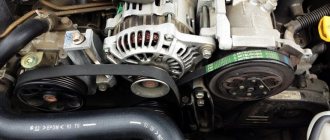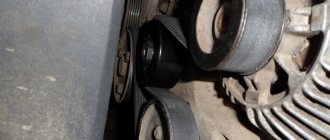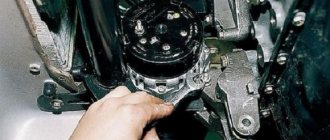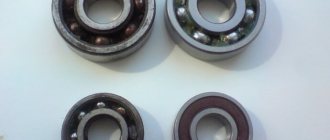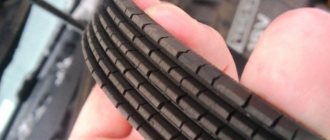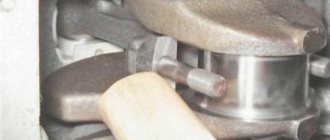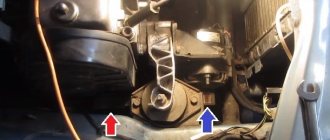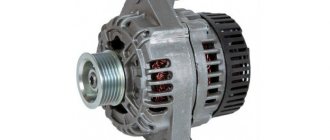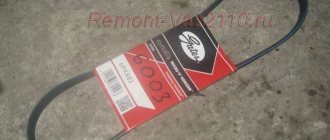Withdrawal procedure
- First of all, remove the belt from the generator.
4. Unscrew the tension bolt.
5. Unscrew the top mount of the generator.
6.Remove the tension bar.
7. Unscrew the lower mount of the generator.
8. Remove the spacer bushing.
9. Remove the generator mounting bolt and remove it.
Generator from viburnum to Priora
Generator serial number: 9402.3701-14 (also 2170-3701010-10, 21700370101010)
Applicability: vehicles VAZ-1117, -1118, -1119 (Kalina), VAZ-2170, -2171, -2172 (Priora Lux), VAZ-2190 (Granta)
Features: Alternating current generator 9402.3701-14 with a built-in rectifier unit and voltage regulator, designed to work as a source of electrical energy in parallel with the battery in the electrical system of the VAZ-1117, -1118, -1119 (Kalina"), VAZ-2170, -2171, -2172 (“Priora” Lux), VAZ-2190 (“Granta”); operating at ambient temperatures from minus 40 C° to plus 45 C° and humidity 90%. The generator is intended for supply to the domestic market and for export to countries of all climatic zones.
1. Multifunctional voltage regulator 897.3702 (Description). From the factory the relay number is TRT5-01. Integral relay 849.3702 is not suitable for this generator.
2. Restrictive rectifier block BVO8-120-02 (Description). The diode bridge BVO 8-105-02 is not suitable for this generator.
3. Collector ring (alternator rotor track - description)
or a new sample along with a plastic cross (description)
4. Winding (Stator 94.3701100-14) of the VAZ-2170 generator (115A) - (Description). Stator G9402.3701-06 is not suitable for this generator.
5. Generator block (integrated charging relay 849.3702, 897.3702) Tver
Generator 2170-3701010 with output current up to 115A and generator 1119-3701010 with output current up to 85A (engine 11194) are not interchangeable, the mounting points are located in different places. At the same time, in adjusting the belt tension on the engine. 11194 an additional roller assembled with a bracket is used.
I bought a generator a long time ago, it drove 50 thousand and died... the company was BATE, I won’t buy it again.
It was replaced by a new generator from a luxury priory - KZATE 115A. Everything would be fine, everything seemed to be installed fine. For those who have problems with the chip, you can use the old-style reverse chip, it seems to come from 2108. This chip fits without problems:
There were two types of generators in the store, one older, the other newer, there are no design differences, they can be distinguished by two things: - on older generators there is a yellow sticker on the plastic cover with cat. number 2170-3701010-10, the new one does not have it - on older generators there is a PCT conformity mark, which no longer exists; the STP conformity mark was made to replace it. PCT on old ones, STR on new ones. Everything else is visually the same. Below is a comparison photo of the labels:
There is no difference which one you take, they are absolutely identical in characteristics and internals, the only difference is in the labels.
But the happiness did not last long... a problem was noticed. When the gear was reset to neutral, or the gas was reset to XX, the voltage dropped to 12 volts, and after 1-2 seconds it rose back to 14. At the same time, this was not a drawdown somewhere in the instrument panel or BC, the low beam dimmed, and the speed of the stove slowed down.
There were long thoughts about what the problem was, somewhere I came across a topic with a regulator, they were installed by Chinese. I decided to replace the regulator, I need to take 849.3702. In the first store it was apparently not uncommon; its cost was about 400 rubles.
Helpful to change. The replacement is nothing complicated, but with a 16kL it’s difficult to get to the generator, but it’s not that much of a struggle either
As a result, they really are a regulator of unknown origin. It says TRT5-01, the date of manufacture and voltage are indicated, there is no information about the manufacturer, where it was made or about the amperage. Replaced it with a new one, no problem. The voltage has increased by 0.2-0.3v and is 14.1v at idle without load, 14 volts with load.
Article: 9402.3701-14 P
- We guarantee fast processing of your order during business hours (we work from 11-00 to 20-00, Saturday and Sunday are days off).
- We guarantee reliable packaging of your order (when sending it by Russian Post or transport company).
- We guarantee the fastest possible dispatch of your paid order (within 2-4 business days after receipt of payment).
- We guarantee a refund or exchange for another product (with recalculation) within 14 days from the date of receipt of the order (the product must be in good condition, without traces of installation, delivery costs are not reimbursed).
- We guarantee a free exchange of goods (transportation costs at our expense) if the purchased goods turn out to be defective.
Dismantling and assembling the generator of a VAZ 2107, 2108, 2109, 2110, Kalina 1118 car
Restoring a generator is a rather complex process. The difficulty lies in the fact that not every motorist can understand the work scheme.
The best option would be to replace the failed device. This is the only way to get rid of problems in the operation of the autonomous battery charging system. However, on the VAZ 2107 and other models, motorists are in no hurry to change generators. The reason is the high cost of new devices. It is easier for drivers to pay specialists for repairs or restore the generator themselves.
The repair process consists of several steps that must be performed sequentially. Only following a certain procedure will allow you to restore the mechanism correctly.
Replacement of brushes, as well as other small structural parts, must be done in a workshop. If the use of specialized equipment is not possible, repairs in garage conditions will be much more difficult.
- It is necessary to unscrew the armature shaft nut. For convenience, you can fix the shaft with a bar wrench. The nut in this position can only be unscrewed with an open-end wrench.
- Once the nut is unscrewed, you need to pull the drive pulley off the axle.
- The segment key is removed from the axle.
- After this, they begin to dismantle the brush holder and voltage regulator. To do this you will need to unscrew the fasteners.
- It is recommended to mark the position of the bearing holder on the reverse side and then unscrew the fastening hardware. As a result of these manipulations, it will be possible to separate the front cover from the back.
- When using a specialized puller, you must follow the order in which the grips are installed - they are inserted under the holder plate.
- The internal screws are removed if the bearing needs to be removed from the shield.
- Press out the bearing.
- Unsolder a special holder for the diode assembly. For safety and convenience, it is better to hold the wires in the area between the soldering iron and the stator using pliers.
- Remove the rectifier diodes.
Checking the brushes is quite simple. You need to make sure that there is contact with the slip rings. After this, you need to check the movement of the brushes in the guides. If problems are detected in the operation of this mechanism, cleaning of the fasteners is required.
The protrusion of the brushes must be at least 0.5 mm. If this value is less, the brushes urgently need to be replaced.
It is also necessary to check the operation of the rotor and stator. The first element is checked for contamination. If dirt is detected, the oily parts are wiped with solvent. If various scratches appear on the product, you can polish the surface with polishing paste.
The winding is checked with an ohmmeter by connecting two contacts to the rings. The optimal range is 3.4 - 3.7 Ohms.
The stator on Kalina and other models is also easy to check. If the assembly overheats, it means there is a short circuit in the windings. In this case, one probe is applied to the plate-type rings, and the second one in turn to the stator wires.
For assembly, use the reverse order of the disassembly shown. During installation, you must carefully monitor the correct location of all parts.
Assembly of the Lada Kalina generator
Before you begin to fit the bearing into the front cover of the generator, you will need to inspect its seat for deformed areas. If they are found, you need to straighten the wrinkled areas using a knife or scraper. When seating the front bearing inside the casing, do not press on the central part; the part should be inserted by pressing on the edges of the outer ring.
Having selected the desired frame from the cup puller set, fit the bearing tightly onto the front casing of the generator. Using gentle blows of a rubber hammer, you need to correct the rolling of the bearing inside the casing. Using a small tube (18 mm), slide the rear bearing onto the rotor shaft.
Before you begin mounting the rear bearing, you need to make sure that the shaft is well clamped in the vise. You can put a small wood chip under it. This will help secure the front rotor wing during the bearing installation process. In order not to damage the bearing, you need to hit only its central part with a hammer.
The rest of the generator assembly is carried out in the reverse order of disassembly. Here the marked marks that were applied during the dismantling of the generator will help you. The fastening of the unit should be tightened in the mode of a car wheel, that is, crosswise. In this case, you need to tighten the bolts gradually, without tightening them all the way right away. After successful tightening, the rotor should spin without unnecessary effort or stopping. If it sticks, it means that the generator casing is assembled incorrectly. Before attaching the plastic casing, you need to make sure that the stator winding is securely fastened.
Repairing a Lada Kalina generator is not a very labor-intensive process, but it requires care and some experience working with electrical appliances. If you encounter difficulties in servicing the unit, you must entrust this matter to qualified specialists at dealer service stations.
LadaKalina LadaKalina 2 LadaGranta Sport
Installing a generator on a VAZ
The installation process deserves attention, since this step can be called one of the most critical stages of repair. The quality of the generator will depend on the correct installation.
- When lifting the generator to the engine, it is necessary to put the device on the mounting location. Special brackets are often located on the engine. It is to them that the installation is carried out.
- Support the fixture and install the lower mounting bolt for the generator.
- When installing special hardware, you must remember that there is a washer.
- After this, you need to put the wires on the stator winding plug and on the brush holder output.
- Screw the nut securing the wires to the generator connection point.
- Put on a protective cap.
- Put on the washer and screw the nut to the tension bar that secures the device.
- Place the belt on the generator and pump pulleys.
- Tighten the drive belt tensioners.
- Strengthen the tightening at the point where the generator is fixed to the tensioner bar.
- Install the dirt shield.
Detailed review of alternator replacement:
About the Kalina generator tensioner
In April 2011, a pilot batch of 1000 elastic belts 1118-1041020-07 manufactured (Germany) was installed. These Kalinas do not have an alternator belt tensioner, all problems caused by its absence are solved, like the Lada Granta. On other Lada Kalina cars, the alternator belt tensioner is present.
Generator mounting bolt on Oka
On the Oka and many VAZ models, the lower fastening is additionally tightened. For this, an M8 × 1.25 × 16 bolt is used. Parts can be adjusted at any time without fear of the threads being damaged. The main thing is to give preference to high-quality fasteners.
Thus, it is possible to carry out maintenance of the generator yourself. To do this, you will need to read the step-by-step dismantling instructions. In some cases, generator parts can be repaired without completely unscrewing the mounting bolt. However, such work will take more time.
The best option is to remove the device, which will allow you to easily replace the brushes. Also important is the restoration of the voltage regulator - the main element of the generator. To check the voltage regulator, use a charger or an regulated power supply.
Hello to all those celebrating ( : ! Congratulations on the upcoming eN Ge on the 14th ( : ! I decided to write what I did not have time to write that year. There will be many letters ( : ! Gennady began to show signs of his ill health at the end of summer, this was manifested in in the form of the rustling of the bearings. The bearings were bought and were waiting in the wings, but with the repair I took more and more time. As they say, until the roast rooster pecks, the man can’t cross himself! And because of my laziness, for the most part, I missed this moment and the crocodile said on his incomprehensible spinning shaft, something like: “Grry drty drynt squabbles and Happy New Year, please send NAFIH owner!”.
When he lived out his last days, there were the following symptoms: - very noisy and loud operation of the generator; — generator low charge, very low: 9 -11 V; — endless whistling of the belt.
The car was left for a week near the house. A little creativity in my performance (: .
During this week I removed the generator near the house, through the top, then as it turned out, I had to do all this wisely, more on that a little later. There is a service station near my house, for a hundred rubles they let me disassemble the generator using their tools, so two days passed. When I installed the bearings, it immediately became clear that everything was broken due to the bearings not being replaced in time. The play of the rotor axis along the generator was, to put it mildly, terrible. Verdict: replacement with a new generator, bearings did not help.
I started looking for Gena with a higher current output. There was no point in installing an 80-amp one, so I started looking for a 100-amp one. The search path led me to Volga Motors on Nikitina Street. There were three versions of crocodiles: Russian, Belarusian and Bulgarian, I think I don’t remember exactly, it was almost a month ago. The seller unpacked all three and after a short comparison, the choice fell on the Belarusian one, BATE 110 ampere. I liked the assembly, very high quality.
I also put the gene through up. Guys, this is a complete f*ck, put it through the top! In general, I installed almost everything and then there was a problem, the belt tension adjusting plate (let’s call it that), or rather the bolts did not want to be screwed into the block that attract this plate. What was my mistake when I removed the gene through the top. This plate had to be removed, because... According to another gene, I couldn’t pull it out through the top; I could have pulled it out through the bottom, but I have protection. The position of the car made it impossible to climb down and unscrew it. The plate was screwed onto one pin, which stuck out from the block; I could not tighten two bolts.
Everything was ready, the key to start and here it was, happiness, the car was working, the generator was delivering an excellent charge, I was pleased with the absence of any extraneous noise.
Thanks to the generator, the torque from the power plant is converted into electrical energy. During rotation, the rotor creates a magnetic flux, which is regulated by a relay, and the pulley carries out a belt drive. The rotor moves with the help of bearings, and when they work well, the shaft moves easily.
Another purpose of the relay regulator is to limit the output voltage in the range from 13.6 to 14.7 V. The voltage is transmitted through the commutator rings to the brushes, and the rectifier bridge is responsible for ensuring that energy is transferred in one direction.
Video “Replacing the belt on Lada Kalina”
The author Kalinin talks about the procedure for replacing the belt on his Kalina with a tensioner.
Hi all. So I’m on my way to work and here on you:
Battery charging disappears. At lunchtime I went out, threw the multimeter probes on the battery with the engine running, it gave about 12 volts - this is bad. I removed the negative terminal of the battery, and with the engine running, it stalled. This means there is a problem with the generator... I took the battery to work. Thanks to my colleague for borrowing the charger. I put the battery on charge until the end of the day... In general, I was able to get home on one battery) The next day I started removing the generator. There is nothing complicated (if you have the tools), just jack up the right side.
We remove the terminals from the washer fluid reservoir motors, unscrew the reservoir (unscrew the near bolt and loosen the far one) and move it to the side.
Loosen the nut (head 19) of the roller tensioner and screw in the pin (head 8), thereby loosening the tension of the generator belt.
The generator has to be removed for various purposes, for example, to repair it, modify it, check it, or replace it with a new one. Sometimes in order to gain access to other elements of the engine compartment. The process of removing the generator may vary depending on the engine type and vehicle configuration. The instructions presented below will also be useful for replacing the alternator belt.
Necessary parts and tools for repair
Troubleshooting the cylinder head begins with the purchase of original parts and various consumables, the list of which is as follows:
- Fuel intake system valve 8 pcs. (art. 21120-1007010).
Exhaust gas valve 8 pcs. (art. 21120-1007012).
Installation of valves on a VAZ 2112 is carried out using a standard set of tools, as well as several specialized types of keys:
- standard set of spanners from 8 to 24 mm;
- socket sockets in a set from 8 to 27 mm;
- end internal hexagons;
- mechanical valve retaining ring remover (depressurizer);
- torque wrench for tightening the cylinder head and camshaft bolts;
- paste for grinding valves (set for rough and fine grinding);
- metalworking cloth gloves to protect hands while working.
The work of replacing 16 valves on a VAZ 2112, the price of which as of this fall is about 50 thousand rubles at AvtoVAZ dealerships (or approximately 35-40 thousand rubles at ordinary car repair shops), is not a very complicated process. You can carry out the work yourself, for which it is enough to purchase the above-described spare parts and the necessary tools.
The reason why the VAZ Kalina generator howls
- Registration
- Entrance
- To the beginning of the forum
- Forum Rules
- Old design
- FAQ
- Search
- Users
Good day, gentlemen!
The other day I started 21103 and there was a strange howl (not from the engine), but from the generator. Later I noticed that at speeds less than 1000, the battery light comes on (i.e. there is no charging).
How to solve the generator whine problem? The belt is tensioned as expected
hmmm, I'll have to look at what and how this weekend
Damn diode bridge. Smart guys. He has something to do with it.
Look at the brushes, belt, and bearings.
And the bridge has nothing to do with it.
I’ve had this gimmick since the car was born! I ask my service station workers - they stand like sheep, and the manager (shaggy bastard) generally said: - This is a feature of these engines. - jerk!
Essentially: when it’s cold, in the range from 65-75 degrees - strongly, when the engine is warm - in places, not so “defiantly” - “SOMETHING” was whining (moaning), at first they suspected either the pump or the gene - after we tried to change the electrical load, it became clear - gene! When you turn on the maximum electrical equipment, the howling becomes stronger. The “specialist” tried the gene belt and said that it was too tight - he let go - I started it - quietly - hurray! — I clacked the equipment — it’s normal — I arrive at the garage — I hear — howls — HERE’S MOTHER OF EVO! I tried to adjust the belt tension myself - sometimes more, sometimes less - the result: it howls in any situation - if it doesn’t howl when it’s cold, then it will when the engine is warm - and vice versa!
So please enlighten me on what is there and where to look and tweak? GENA IS NOT COVERED YET.
Source
➤
What types of breakdowns are common?
Most often, the generator for 8 and 16 valve VAZ-2110s fails as a result of moisture and dirt. Another reason is the wear of the components of this assembly, namely the brushes. Most often, the malfunction manifests itself as follows:
- the generator does not produce electricity;
- output current is either too high or low voltage;
- During engine operation, extraneous sounds are heard, most often a squeak or squeal.
The operation of the generator is checked using special stands or a digital voltmeter. If extraneous sounds are heard in the engine compartment area, then first of all you need to check the timing belt tension. Most often this is the reason, but after checking, remove the belt from the pulley and start the engine. The absence of noise is a reason to check the performance of the generator more carefully.
How to get rid of a whistling alternator belt on a Lada Priora - step-by-step instructions
To carry out the manipulation, loosen the fastening bolts, then tighten the adjustment bolt a few turns, achieving optimal tension. A correctly tensioned drive should bend no more than 1 cm under hand pressure. If this cannot be achieved even with the bolt tightened to maximum, the belt should be replaced.
If the pulleys become oily, the drive should be removed and the inside should be wiped with alcohol or gasoline. Pulleys are cleaned in the same way. If the belt has been in an oily state for a long time, it is recommended to replace it, since fuels and lubricants destroy rubber. Also, current seals and gaskets must be changed.
If, as a result of diagnostics, it was revealed that the front bearing of the generator is whistling, it is replaced. To do this, remove the unit from the car, dismantle the front cover and, after removing the faulty bearing, press in a new one. This is also done when the pulley is skewed and the generator shaft is jammed.
Where is the generator for 2110 located?
The VAZ 2110 generator is located in the engine compartment on the left side (located closer to the engine cooling radiator).
You can also notice that the engine crankshaft is connected to the generator using a belt. Let us add that the generator on the VAZ 2112 is located by analogy with the “ten”.
In terms of operation, the installation location is not the best, however, the location of the generator is quite convenient for servicing or removing the device. In practice, before dismantling, it is advisable to treat the generator mounting with a penetrating lubricant (such as WD-40).
Trouble-shooting
If, as a result of the diagnostics performed, you were able to find out the reason for the battery light to light up, the malfunction should be eliminated.
If it turns out that the battery has run down, it needs to be recharged. In this case, you need to start the car with a starting charger - this will make sure that the generator is functioning normally and the light has gone out.
If the generator belt is loose, tighten it using the appropriate tensioning mechanism. If the belt is damaged, it is replaced with a new one, followed by the tensioning procedure.
If you find damage to the wiring in one of the sections of the circuit, it must be replaced, but the wires must have the same characteristics as the old ones.
If the voltage relay or diode bridge burns out, these components are replaced with new ones; they cannot be repaired.
As for the generator, worn commutator brushes can be replaced, and the same applies to slip rings. But a broken winding is almost impossible to eliminate, so most likely you will have to buy a new generator.
How to properly remove the generator on a VAZ-2110
If you have a power unit with 8 valves, then it is best to work from above. In the sixteen-valve version, the generator must be removed from below. To do this, first unscrew the pan. Before work, prepare several different keys. You can remove this assembly quickly if you follow the following instructions:
- De-energize the vehicle's on-board system - to do this, simply remove the negative terminal from the battery.
- Find the M10 nut on the positive stud of the autogenerator and unscrew it.
- There are wires connected to the generator on the back of the device, which must be disconnected before the next stage of disassembly.
- Using a 13mm wrench, loosen the upper and lower nuts.
- Unscrew the tension bolt with a 10mm wrench to loosen the belt tension and remove it.
- Then completely remove both nuts (upper and lower) and remove the tension bar.
- Carefully rotate the generator at a right angle and remove it from the engine compartment.
If you want to repair this unit, you should thoroughly wipe it with a rag to remove all dirt.
Step-by-step instructions for removing the generator from a Lada Granta car
Before altering the mount, we remove the converter from its standard place in the engine compartment. To do this, perform the following steps:
- We place the car within the perimeter of the repair area, provide safety measures, and secure the rear row of wheels with wheel chocks. Additionally, squeeze the parking brake lever.
- Open the hood and disconnect the terminals from the battery to prevent a short circuit in the circuit.
Accumulator battery
- We unscrew 6 bolts under the bottom of the car and temporarily remove the oil pan protection.
- Remove the protective cap and terminals from the contact board on the converter.
Removes clamps
- We unscrew the nut of the upper fastening (key set to “13”), and use the mounting tool to move the converter to the side. Unscrew the lower mounting bolt.
Unscrew the nut and bolt
- We remove the generator belt from the pulleys.
- We remove the converter assembly and fix it on the surface of the workbench.
Removing the converter
Parts diagram
Installation of the generator with subsequent adjustment
When installing a generator on a VAZ 2109 (no matter the injector or carburetor) and other models, be sure to check whether the purchased clamps, bolts and nuts fit the installation locations. Also, we must not forget that the mounting holes on old-style electric generators are different from new ones. Therefore, when installing a modern autogenerator on front-wheel drive models of the first generations (08, 09, 99), you should purchase the appropriate fasteners.
The generator mounting mount cannot be taken from Grants or Prioras. You can take a new potassium generator and no additional modifications will be required, but the mounting plates must be type 21082. In addition, you will need to purchase a pulley 2110 and a tensioner type 21082.
The installation process is identical to the removal process. If the standard strips are worn out, they are replaced with new ones; this will require unscrewing several bolts and installing new strips.
When installing the electric generator, start from the bottom fastening plate, tighten (but not completely) the fixing bolt (do not forget to put the bushing), put the belt on the pulley and move to the top. To fix the generator, install the top fastening, but do not screw it all the way. Then the tension bar is inserted. Then tighten the tension bolt, checking the belt tension.
The belt should not bend more than 1-1.5 cm when pressed with a force of 10 kgf. It is quite difficult to maintain these indicators in garage conditions, so you should focus on the gap between the frame and the tension bolt of 15–20 mm. There should be a small gap (15–20 mm) between the tension frame and the screw (from the thread side). Then turn the engine crankshaft two turns with a wrench and monitor the position of the belt and its tension.
If, after checking the engine by turning the key, the gap changes, then the bolts securing the electric generator should be tightened. As soon as, after a control rotation of the crankshaft with a key, the gap remains the same, and the belt bends slightly when you press it, the bolts of the upper and lower fastenings are finally tightened, a control rotation of the crankshaft is performed two turns, the wires are connected to the electric generator and the engine is started.
If, when starting the engine, the belt does not make unwanted noise or whistle, and the charge level is normal, then the installation procedure was completed correctly. If a whistle appears, then most likely the belt is too tight and should be loosened.
Video about tightening and adjusting the belt:
Installation of generator from 2110 to 2109/08/99 – video:
Did you manage to solve your problem using the recommendations from the article?
No. More answers required. I'll ask in the comments now.
Partially. There are still questions. I'll write in the comments now.
General questions about working with the Grant generator
Let's consider general questions: everything except replacement.
Tension check
There are two approaches: visual assessment and physical.
Visual assessment of condition:
- the car is on a flat surface, the gear is in neutral, the handbrake is off, the hood is open;
- We don’t start the car - we put it in 5th gear;
- We opened the hood and found a generator: we push the car back, resting against the bumper;
- We inspect the required part along its entire length: are there any breaks or cracks? It needs to be changed.
Poor quality will lead to unexpected problems on the way. Physical assessment :
- if you have a tool that measures pressure force: press the belt with a force of 10 kg*s - the deflection should be no more than 10 mm;
- there is no special tool: we try to turn it across - it should turn no more than 90 degrees.
How to tighten the alternator belt on a Grant
This section applies only to machines with a tensioner. No - change the part or see above how to install it.
Subsequence:
- we use ring wrenches 8, 19;
- Throw key 19 onto the lead screw;
- wrench 8 for locknut;
- we touch;
- Now you can turn the lead screw: clockwise to loosen, counterclockwise to tighten;
- got the desired result - tighten the locknut.
It is better to take ring wrenches, since a head with a ratchet or a wrench will not work.
How to disassemble a generator
First, make two marks on the metal covers. This will help you later assemble the unit without problems.
- Press out the metal latches and remove the plastic cover.
- Use a Phillips screwdriver to unscrew the voltage regulator mounting screws.
- Unscrew the M10 nut. Then use a screwdriver to remove the screw and remove the capacitor.
- To remove the pulley, clamp the generator housing in a vice. Put a 21 socket on the nut, and through the hole in the head put a 8 hexagon on it. Only after you unscrew the nut can you remove the washer and pulley.
- Remove the four mounting screws to disassemble the generator into two parts.
- From the back of the housing, unscrew the screws securing the stator wire and diode bridge.
- Remove the diode bridge and the oscillator winding.
- Press the rotor out of the cover with your fingers along with the bearing.
- Carefully remove the bearing bushing.
- Take a puller and remove the bearing.
Replacing bearings
AvtoVAZ cars are very often subject to fair criticism from the owners of cars produced by this company. The Lada Kalina model was no exception to the general rule. Almost all current converters installed on cars of this brand break down after 10 thousand kilometers, after which the generator requires repair or replacement. As practice has shown, the cause of many breakdowns is not only the bearings, but also the Kalina generator bracket. Car owners often fix this problem on their own. Doing this with certain skills is not so difficult.
To repair the generator, it is necessary to disassemble it. To do this, use a screwdriver to hook the tips of the stator wires and pull them out a little from the springs of the diode bridge. Then unscrew the bolts that attach the diode bridge. After this, the connecting bolt is unscrewed.
After disassembling the generator, check whether the rear bearing is in good condition. To do this, you need to twist its outer ring. If it rotates easily, without noise or rattle, and there is no play, then the bearing is in good condition. At the slightest suspicion of a malfunction, it is better to replace the bearing.
Next, you need to dismantle the Kalina generator bracket. Using a screwdriver, the stator is picked up and removed from the device casing. The bracket includes a bearing, which should also be checked. If a malfunction is detected, the part must be replaced.
The front bearing of the unit is rolled into its casing. Although AvtoVAZ does not recommend changing it, it would still be more advisable to do so, because otherwise you may then need to buy an expensive new generator for Kalina.
The bearing is removed by removing the pulley and spacer plug. After this, the rotor is removed from the rubber using a hammer, and the front casing of the unit is clamped in a vice. The bearing is carefully removed.
Replacing timing belt VAZ 2110 16 valves
Replacing the VAZ 2110 timing belt 16 valves in VAZ 2110, VAZ 2112 cars. Requires regular performance. Of course, an injector with sixteen valves adds agility to our Lada and this is pleasantly pleasing. There is a fly in the ointment. The timing belt must not be allowed to break due to wear. This leads to damage to the cylinder head.
The content of the article:
How to avoid valve failure
The camshafts are stationary and at the moment when the piston approaches top dead center, the valves remain open, resulting in the piston hitting the open valves, which leads to the valves bending and in some cases destroying the seats and guides. Repairs are of course expensive.
This can be avoided by installing pistons in the engine with recesses for the valves, such as in the photo. It is not advisable to replace this on purpose, since engines have a significant service life, and there is no point in disassembling a working engine. Therefore, it is easier and cheaper to simply change the timing belt in a timely manner, especially since it does not require extensive experience in locksmith work and deep knowledge in the field of car repair, but just attentiveness and knowledge of some of the nuances when installing the belt itself.
Disassembling the timing belt
Where to start replacing the belt. First, you need to remove the alternator belt drive pulley. It’s convenient to do this if you remove the right front wheel and the protective cover, if you still have one. The pulley mounting bolt must be unscrewed. Then remove the timing belt protection covers and the mechanism before your eyes. The nuts securing the tension rollers must be unscrewed so that when replacing the belt, the rollers can also be changed, and remove the rollers, then remove the belt itself
Vehicle voltage
For normal operation of all consumers in the car, the generator must maintain a certain voltage; for the Lada Kalina on-board network, with a working generator, it must be in the range from 13 to 14.8 volts.
Within specified limits, the voltage is provided by a relay regulator, and with any deviation from the specified norm, various problems arise:
- At high voltage, the electrolyte in the battery banks boils, and the battery quickly fails;
- If there is insufficient charging, there is not enough current for consumers, as a result the battery quickly discharges.
The voltage generated by the current source is measured in the following way:
- On a digital multimeter (voltmeter), set the limit to 20 volts;
- We connect the probes of the measuring device to the battery and start the internal combustion engine, the voltmeter should show a voltage of about 14 volts;
- Without turning off the engine, we turn on the load - headlights (high beam), heater motor at maximum speed, windshield wipers, radio, etc. If the generator is in good condition, when the engine is idling, the voltage should not fall below 13.2V, optimal The voltage is considered to be 13.7-13.9 V.
POPULAR WITH READERS: What is remarkable about the Lada Largus Cross car
Malfunctions of the VAZ-2110 generator
Now let’s look at the breakdowns of the “tens” generator, which car owners have to deal with most often. These include:
- incorrect tension of the drive belt;
- bearing wear;
- failure of the rectifier unit;
- malfunction of the voltage regulator relay;
- break (short circuit) of the rotor or stator windings.
Let's look at each of the faults in detail separately.
Checking and adjusting the tension of the Kalina generator belt
We press the lower branch of the belt upward with our hand; with a pressing force of 100 N (10 kgf), the belt deflection should be about 10 mm. In the absence of a special tool, household scales can be used.
- Excessive belt tension causes increased loads on the belt, generator bearings and tension roller, which leads to premature failure.
- Insufficient belt tension will cause it to slip on the pulleys, causing wear and preventing the battery from charging.
If the belt tension is not correct, then:
- To tension the belt, rotate the adjusting pin counterclockwise.
- To loosen the tension, rotate the adjusting pin clockwise.
How to properly maintain and repair a generator on a VAZ 2112 on your own?
In a VAZ 2112 car, the generator is designed to power electrical equipment when the engine is running. If this unit fails, full operation of the car will be impossible, so the driver may encounter certain difficulties while driving. You can read more about the principle of operation, as well as the replacement of some elements of this unit, below.
Technical characteristics and principle of operation of the generator set on the Dvenashka
First, let's look at the operating principle of the 2112 generator. One of the main design elements is the rotor, which performs the function of generating a magnetic field. This component is a shaft on which the field winding is mounted. The halves of this winding are installed in special pole parts, and the winding is supplied with current thanks to slip rings. The rotor rotates thanks to a belt drive from the drive.
Removing the Unit Cover
Another equally important component is the stator, consisting of a core and a winding. This mechanism produces alternating current that passes through the electrical network through slip rings. To supply current to the rings, the design of the unit is supplemented with special brushes. After them, according to the scheme, a rectifier unit is installed, which is used to convert the voltage that the device produces. Depending on the device model and its technical features, different winding connection diagrams can be used.
The generator unit relay is used to maintain the voltage within specified limits. This element, if necessary, changes the frequency and duration of electrical pulses. By design, a relay consists of several controllers, as well as executive components. The purpose of these components is to determine the time during which the field winding must be connected to the network. If the relay fails, an unstable voltage will be supplied to the battery.
As for the technical characteristics of the generator on the VAZ 3701010-07, the voltage limits generated in the winding are 13.2-14.7 volts. The unit itself allows you to generate current up to 80 amperes. It is important that the VAZ generator belt is tensioned properly, otherwise the operation of the device as a whole may be incorrect. If you want to check the belt tension with your own hands, then keep in mind that when there is pressure on it with a mass of about 10 kilograms, the deflection of the belt should be at least 8 mm (the author of the video is the channel In Sandro’s Garage).
Service Features
The need to repair the generator unit on a VAZ 2112 16 valves does not arise often, but in order for the unit not to have to be repaired, it must be properly maintained. In general, this unit has a fairly high margin of reliability.
What maintenance features must be observed to prevent repairs:
- It must be remembered that the outer surfaces of the unit must always be clean.
- When carrying out maintenance, you also need to check the quality of fastening of the unit - it must be securely fixed at the installation site.
- It would be a good idea to check the functionality of the voltage regulator; a multimeter is used for this.
- The same applies to belt diagnostics. As stated above, first of all you need to check its tension - the belt should not be too tight, but it should also not be loosened. In addition, diagnostics of the condition of the strap should be carried out every 10 thousand km - there should be no signs of damage, cracks, and the belt should not peel off.
- Another point in maintenance is checking the condition of the bearings. For diagnostics, you need to remove the strap, and the rotor of the unit must be rotated by hand. If during rotation you feel a gap or even slight jamming, then the bearing devices need to be changed. The same applies to the appearance of sounds uncharacteristic of their normal operation.
Photo gallery “Main device malfunctions”
1. New and worn brushes 2. Bearings with frozen grease 3. Worn belt
Possible malfunctions and ways to eliminate them
The need to repair a generator unit may arise for various reasons. As practice shows, the most common of them are failed brushes or bearings. Read below about repairing these components.
There is bearing noise when the engine is running, from the side of the generator and the timing belt, in order to accurately understand whether it is the generator or the tension roller, you need to remove the generator belt and start the engine, if the sound remains, we change the rollers, and if the sound disappears, we proceed to replacing the generator bearings. Loosen the generator mounting nut and the adjusting bolt. We remove the generator belt and start the engine; if the bearing noise disappears, we continue disassembling. Disconnect the negative battery terminal and disconnect the wires from the generator. We unscrew the front part of the crankcase protection, unscrew the lower mount of the generator. We remove the generator through the bottom. Carefully block the generator rotor with a screwdriver and unscrew the pulley. Pull back the latches and remove the casing.
We unscrew the brushes and four bolts of the generator halves. We make marks on the two halves and use a screwdriver to remove the back cover. Screw the nut onto the rotor thread. The easiest way is to remove the rotor from the front cover bearing, grab the ears of the generator front cover with both hands and tap the nut on a piece of wood. We place a suitable object on the bearing, in my case a 27mm head, and knock it out. Carefully open the new bearings and fill them with grease. We drive the new bearing through the old one. To securely fix the bearing in the cover, use a core or chisel to flare the edges. We are replacing the rear bearing of the generator. We place a thin chisel, a thick screwdriver or something like that under the bearing and hit it with a hammer from above, moving the chisel in the opposite direction.
Removing and disassembling the generator
Disconnect the wire terminal from the negative terminal of the battery.
Remove the generator belt (see “Checking the condition and replacing the generator drive belt”). By pressing the lock of the generator pre-excitation wire block. . disconnect the block from the voltage regulator connector.
Using the “13” socket, unscrew the nut securing the wire lugs to terminal “B+”. . and remove them from output.
Using a 17mm socket, unscrew the bolt of the lower mounting of the generator and remove it. Remove the nut from the generator bracket.
Using a 13mm socket, unscrew the nut of the bolt for the upper mounting of the generator.
. and remove the generator. We disassemble generator 5132. 3771 to replace the voltage regulator, rectifier unit, rotor, stator and bearings.
Using the “8” socket, unscrew the three nuts securing the casing.
. and remove the casing.
Remove three metal washers from the casing mounting studs.
Using a slotted screwdriver, unscrew the two screws securing the voltage regulator terminals.
Using the “8” socket, unscrew the two nuts securing the voltage regulator.
. and remove the regulator.
We use a marker to mark the relative positions of the generator covers.
Using a 7-point socket, unscrew the four bolts holding the covers together.
Remove the back cover with the stator assembly. If the stator does not come out of the front cover, pry it off with a screwdriver from different sides relative to the front cover.
We put a high “24” head on the pulley fastening nut and through its hole insert a “8” hexagon into the hole of the rotor shaft. We unscrew the pulley fastening nut, holding the tool head with a pipe wrench or in a vice. Remove the spring washer
. and a spacer washer.
Push the rotor shaft out of the front cover.
. and remove the cover to replace the front bearing.
. Using a slotted screwdriver, unscrew the four screws securing the bearing pressure plate.
Remove the pressure plate.
Use your hands to push the bearing out of its seat.
. and remove it. If it is not possible to push out the bearing, we knock it out using a mandrel or tool head of a suitable diameter. To replace the rear bearing...
. Using a two-jaw puller, press the bearing from the rotor shaft. When performing this operation, the puller screw should be pressed exactly into the center of the shaft so as not to damage the plastic insulator of the rotor slip rings. To install the puller grips, two flats are made on the plastic rotor bushing. If it is necessary to remove the rectifier unit or stator.
. We unsolder the six terminals of the stator winding from the terminals of the rectifier block. . and, having unscrewed the three fastening nuts with a “8” wrench, remove the rectifier unit and the stator. Using a tester, we check the stator and rotor windings for open circuits and short circuits to the housing (see “Checking the generator”). We assemble the generator in the reverse order. To install the rear bearing, rest the front end of the rotor shaft on a wooden block.
. and press the bearing onto the rear end of the shaft using a mandrel or a piece of pipe of a suitable diameter, applying force only to the inner ring of the bearing. If the front bearing cannot be inserted into the generator cover...
. We press it in with a suitable tool head, applying force to the outer ring of the bearing.
Tell me how to remove and replace the Lada Kalina generator? Otherwise there is not enough voltage, last time I changed the regulator. But it didn’t help for long, I want to install a new one that’s more powerful.
- The reason for the whistling of the generator on the VAZ Kalina - 7 answers
- VAZ Kalina generator fire – 3 answers
- Generator failure on Kalina, station wagon – 3 answers
- Why doesn't the new generator charge? – 3 answers
- Kalina has trouble starting - 2 answers
There seems to be nothing complicated about removing and replacing the generator on a Lada Kalina...
Replacing the generator on VAZ 2110-2112 and 2114-2115
You can remove the bearing with a large open-end wrench, using it as a lever. Drive a new bearing through the old bearing and head 27, or you can use a piece of tube or a tubular wrench to press in a bearing of a suitable diameter. The generator bearings have been replaced and assembly can begin. Assembly must begin with the front cover of the generator, and then proceed in the reverse order of disassembly. Replacing generator bearings for VAZ 2111 and VAZ 2112 is similar. Often, many VAZ 2110-2112 car owners are in too much of a hurry at the first generator malfunction and prefer to replace it with a new one, instead of simply finding out the cause of the breakdown and eliminating it.
In this case, we will not consider repairing this device, but will only look at the procedure that must be performed to remove and install the unit. So, in order to dismantle it without problems, we will need a tool such as: Especially for this post, I decided to make a video instruction to explain everything clearly and clearly. If you have any questions about the video review, you can ask them on my YouTube channel. Below will be presented everything in the usual format. I would like to warn you right away that in this example of my VAZ 2110, the generator is slightly clamped by the mounting bracket, since it broke off during the accident, so I cannot show you the removal procedure in all its details. But still, the main points will be shown quite clearly in the photo.
We unscrew the tensioner nut, which is shown by the arrow below: After this, move the generator back (towards the car interior) and remove the belt from the pulleys. PNow you can disconnect all power cords. One bundle is attached using a pin and a nut, and another plug is simply fixed with a connector: Then you can unscrew the lower nut securing the generator, first crawl under the car and remove the engine protection (if installed): Usually the bolt sits tightly, so you can carefully and without excessive force, knock it out with the handle of a hammer: Next, unscrew the tensioner nut from top to bottom and you can carefully move the VAZ 2110 generator to the side in order to remove it later: If you change the device assembly, then install it in the reverse order.
DIY generator replacement
Usually, even factory generators on Kalina serve for quite a long time and do not require replacement, of course, unless you come across a car with a factory defect of this device. If this electrical equipment unit fails, it will have to be replaced. Although this is not difficult to do, it will take at least an hour, especially if this is your first time doing this procedure. So, we will need the following tools:
- Open-end or ring wrenches for 8, 13 and 19
- Small and large ratchets and heads for 8, 13 and 19 for more convenient and faster work
- Wrench with extension
Guide to replacing the Kalina generator yourself
So, let's proceed to a very detailed description of all the types of work that need to be performed. First of all, we need to loosen and release the belt tensioner and then remove it. So be sure to check out this Alternator Belt Replacement Guide first. After this, you can proceed directly to removing the device from the car.
Before carrying out any repairs related to electrical equipment, be sure to disconnect the battery by removing the negative terminal from it.
First, we disconnect the plug, which is secured with a plastic latch, just lightly press it and pull it to the side, it will come out without any problems:
And the wire terminals that are under the rubber protective cap, pry it off and unscrew the nut:
Then we unscrew the nut securing the upper part of the Kalina generator, this is clearly shown in the photo below. You can first move it with a knob, and then work with a ratchet handle:
And tapping the protruding bolt a little so that it moves, remove it from the back side, as shown in the photo below:
Next, we proceed to the lower fastening bolt, and proceed by analogy, only if necessary, hold the nut on the reverse side, since it can scroll:
Be careful when removing this rod as there are bushings there. Hold them immediately so that they do not fall and get lost. And holding the generator body with one hand so that it does not fall, we remove this bolt with the other hand:
Now almost everything is ready and you can safely remove this device from the engine compartment, turning it slightly from side to side, finding the most convenient position for its removal.
To replace the generator on the Lada Kalina, we purchase a new one and install it in the reverse order of removal, putting all the bushings in place in the same places as they were. The price of a new generator ranges from 4000-5000 rubles, so you will have to fork out a little.
Replacing a standard 55A generator (2108-99, carburetor) with an 80A generator (2110-70, injector)
But please note that the generator model, if possible, should be the same as the one installed by the factory. That is, first of all, look at the applicability specifically to your car, and then at the current rating in Amperes. As for the price of generators for VAZ 2110-2112, it may vary depending on the type and manufacturer. But if you take the KZATE model, which in most cases is installed by the factory, then the cost can be about 3,500 rubles. Although, Chinese options can be obtained at almost half the price. True, you should not chase low cost, since the service life of these parts can be quite short.
Technical regulations Lada Granta
The alternator belt is located under the alternator itself
If you rely on the manufacturer’s technical regulations, then the belt should be checked at least once every 15,000 km. And every thirty thousand kilometers, this belt needs to be replaced.
That is, it turns out to be a cycle with an interval of fifteen thousand kilometers, in which the alternator belt is alternately checked and replaced.
And, given that the tensioner, as such, is not used, the belt is focused solely on one-time stretching during installation.
There are options for reusing the belt, but this practice is highly discouraged.
Alternator bearings for Lada Priora: diagnostics, signs of malfunction and replacement
The following circumstances indicate the need to replace the bearing:
Malfunctions of electrical equipment;
Extraneous noises, whistling and humming when starting up;
Slow or insufficient battery charging;
Distinct beating due to uneven rotation of the shaft;
Diagnosis of the malfunction is carried out using the following steps:
- We remove the belt.
- We start the engine and listen carefully. If the extraneous sound disappears, it means the ball bearing was humming.
- We move the pulley. If there is play, the bearing needs to be replaced.
What kind of bearing is needed
Depending on the year of manufacture of the car, the generator can be old or new. They differ in shaft diameter: the new one is 17 mm, and the old one is 15 mm.
- For a 17 mm shaft, bearing No. 303 is suitable.
- Bearing No. 302 is suitable for a 15 mm shaft.
- They have the same rear bearing No.202.
Bearing replacement
For work you will need: Phillips and flathead screwdrivers, 8 and 10 wrenches, 8 and 24 socket wrenches, a hammer. First you will need to remove the generator of the Lada Priora car, and then follow the sequence:
- Remove the voltage regulator.
- Remove the generator cover and remove the stator from it.
- Using a spanner, unscrew the nut holding the shaft from turning.
- Remove the pulley with the spring washer of the generator rotor shaft.
- Press the rotor shaft out of the bearing.
- Remove the 4 screws holding the bearing thrust washer.
- Using a 24mm socket wrench and a hammer, press in the bearing.
Reassemble the product in the reverse order, starting with pressing the new bearing into the generator cover.
Review of prices of generator manufacturers for the Lada Granta
| Manufacturer article number | Price, rub.) | Resource (thousand km) |
| KZATE 9402.3701-14 | From 4900 | 90 — 110 |
| BOSCH 21700-3701010-13 | From 5300 – 5500 | 90 — 110 |
*prices are current as of October 30, 2018.
Recommendations for choosing a converter
In order to ensure stable operation of the power supply system, replace the standard KZATE converter with a BOSCH one. Despite identical technical characteristics, the workmanship of the latter is better.
Also, the BOSCH generator better “transfers” loads in the network from activated equipment, optics, and heaters.
The service life of both KZATE and BOSCH is within 90 – 110 thousand km. mileage Moderate loads and average driving speeds will increase the service life by 10 - 15%.
Stages of work
To adjust the degree of belt tension on Kalina engines, a mechanical tensioner is used, in contrast to the timing drive, which uses a hydraulic tensioner. When changing an element, it is recommended to carry out preventive maintenance of the roller by adding fresh lubricant.
To complete the work you need to do the following:
- Loosen the roller bolt. The thread on it is reversed.
- Use a screwdriver to pry up the plastic plug on the roller and carefully remove it.
- Unscrew the fixing nut on the tensioner rod a few turns.
- Loosen the belt tension by rotating the rod nut clockwise. The nut must be unscrewed until the rod begins to move freely in the seat.
- Unscrew the side bolt securing the rod end, located next to the tension roller.
- Remove the tensioner and set it aside.
- Proceed to dismantle the strap. The procedure must begin with the generator pulley, while overcoming the slight resistance of the belt.
- Remove the element from the crankshaft pulley and remove it completely.
- Unscrew the roller bolt and remove it.
- Using a needle, carefully pry up and remove the protective caps on the bearing. Wash the bearing with white spirit or gasoline.
- Refill with fresh grease and install protective rubber caps.
- Assemble all the parts and mount the roller in place. When assembling, you must remember that the bushing is in the bearing on the side of the bracket.
- Change the belt by installing it in the reverse order - from the crankshaft pulley to the generator pulley.
- Install the tensioner and begin tightening the belt by turning the nut counterclockwise. The nut must be tightened until the resistance increases. A well-tensioned strap should be slightly pressed when pressed by hand.
- Tighten the nut securing the tensioner rod.
- Check the operation of the mechanism; if a whistle occurs, tighten the strap.
How to properly tighten the alternator belt?
Replacing the alternator belt proceeds as follows:
- The bolt is loosened by 2-3 turns;
- When you unscrew the adjustment bolt, the belt tension is loosened, after which the belt itself is removed;
- Inspect the belt, and if there are tears, cracks, delamination of rubber and similar defects, it should be replaced;
- Inspect the pulleys, and if they are clogged or damaged, either replace them or clean them;
- If necessary, the tensioning device can be removed. To do this, you need to unscrew three bolts. For greater convenience, you should move the roller up.
It is worth noting that before you start replacing the alternator belt, it would be a good idea to study the manufacturer’s recommendations, in which you can often find useful information. One way or another, information about the individual properties of your car never hurts.
If there is a need to tighten the belt on the crankshaft pulleys, you can use a narrow metal strip. Be that as it may, in order to avoid various troubles, everything should be followed with maximum precision.
Video on replacing the alternator belt
Upon completion of the belt tensioning work, it is necessary to check the operation of the generator set. First of all, it is worth checking the circuit with the engine turned off. In order for the control lamp to flash on the panel, you need to turn the key. Only after completing these steps can you start the engine. After some time, at average crankshaft speeds, the warning light should go out.
It is worth noting that when tightening the belt, certain difficulties may arise. In this case, it is worth looking for information about the alternator and how to tension the belt for a specific car, since certain technical properties may vary.
The procedure for replacing the alternator belt is not particularly difficult. Almost every driver is able to independently check the belt and, if necessary, tighten it.

